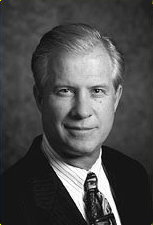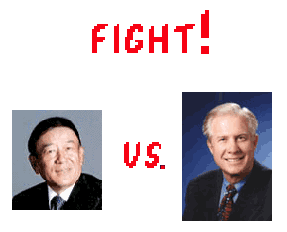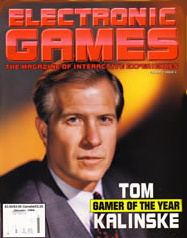Toppling the Nintendo Beast
 Ask just about any gamer what the single worst problem there is at Sega and their answer will almost always be the same: management. No other game company has had such a tumultuous history when it comes to just who was running the show, and there have been four presidents in the last decade alone. It has been a problem that has plagued the legendary software developer since the mid 1990s, when then-president and CEO Tom Kalinske was forced out by a series of horrible business decisions by Sega of Japan. The events surrounding his departure started a domino effect from which the company never recovered, and eventually led to their exit from the hardware business in 2001.
Ask just about any gamer what the single worst problem there is at Sega and their answer will almost always be the same: management. No other game company has had such a tumultuous history when it comes to just who was running the show, and there have been four presidents in the last decade alone. It has been a problem that has plagued the legendary software developer since the mid 1990s, when then-president and CEO Tom Kalinske was forced out by a series of horrible business decisions by Sega of Japan. The events surrounding his departure started a domino effect from which the company never recovered, and eventually led to their exit from the hardware business in 2001.
It may sound odd to say that Sega’s misfortune over the last few years is directly related to their mistreatment of Kalinske, but it becomes quite obvious once you examine the facts. No other president before him ever gave Sega the level of success he did, and none since have ever equaled it. One could even go so far as to say that Sega lasted as long as it did as a hardware manufacturer thanks to Kalinske’s efforts during the 16-bit era.
It sure wasn’t because of Sega of Japan.
Flashback to 1990. Sega of Japan’s lord and master, Hayao Nakayama, was busily readying the debut of the company’s new mascot: Sonic The Hedgehog. The Blue Blur was part of a two-pronged approach to taking on rival Nintendo. The new corporate mascot would be backed by a huge advertising campaign that would throw as much cash as humanly possible at promoting both the game and the Genesis. Though Sega’s new console had sold more than half a million units in America, Nakayama was beginning to feel desperate (a feeling that he would soon get used to) and fired Sega of America president Michael Katz, replacing him with Tom Kalinske. He was well aware that his new candidate, a graduate of the University of Wisconsin (who also has an MBA from the University of Arizona) and former president of Mattel, could make the Genesis a success and wrest away control of the gaming market from the industry’s 800lb gorilla. At Mattel, Kalinske had taken the moderately successful Barbie line of toys and transformed it from a $42 million dollar franchise to a $1 billion dollar a year juggernaut. He had successfully guided the company through the “crash” of 1983 by turning their electronic division into a separate entity – Mattel Electronics. If there was anyone who could turn the Genesis into a hit, it was Tom Kalinske. While not a veteran of the gaming industry, Kalsinske was a fast learner who surrounded himself with highly capable people who knew the ins and outs of video games.
After quick and careful study of Sega’s established marketing strategy, SOA’s new president set off to Japan to inform Nakayama that a change in tactics was needed. He wanted to continue to tackle Nintendo head-on and directly compare the Genesis to the SNES through a slick new advertising campaign. Though Katz had been the originator of the strategy with his Genesis does what Nintendon’t campaign, Kalinske felt Sega needed to go for the throat. It wasn’t enough to simply compete directly with Nintendo; the competition needed to be humbled, ridiculed, and portrayed as having the inferior product. Nakayama, who was not accustomed to such a philosophy, didn’t understand. Moreover, Sega’s board of directors practically called for the upstart American’s head. In the end, however, the ruler of all things Sega was convinced and gave Kalinske his full support. Kalinske himself recalls how events unfolded during that fateful trip to Japan:
After my first month as CEO, I told Mr. Nakayama, “You have to get rid of Altered Beast, the title that’s bundled with Genesis. It sounds like devil worship. We have to get the price down to $149, and we have to develop more American software.” The board spoke for two hours in Japanese and I was just sitting there, not understanding a word. Finally Mr. Nakayama said, “No one here agrees with anything you’ve said.” I thought mine was going to be the shortest career in the business. But as I was walking out, he said, “But I hired you to make the decisions for Europe and the Americas, so go ahead and do it.”
That’s when Sega set the gaming world on fire.
Kalinske’s plan could be summed up in four simple steps:
- Aggressively market the Genesis in the U.S., the biggest market in the world (believe it). This lead to the implementation of the “Sega Scream,” one of the most recognizable ad campaigns ever. (Once more, it must be noted that the idea of directly advertising against Nintendo did not originate with Kalinske. Former Sega president Michael Katz originally challenged the big “N” with the famous Genesis Does what Nintendon’t ads shortly after the Genesis launched.)
- Make people aware of the speed and power of the new system.
- Gear advertising towards the new, “cool” market that was buying the Genesis.
- Drop the price of the Genesis and switch Altered Beast for Sonic The Hedgehog as the pack-in.
Sounds easy enough. During probably the only time in Sega of Japan’s history where management knew what it was doing (as it relates to the U.S.), all of Kalinske’s suggestions were implemented. To say it worked would be a gross understatement. By 1992, Sega had 55% of the market locked up (up from a measly 8%). Even more impressive, the company had grown from a $813 million dollar company in 1989 to a $3.6 billion dollar conglomerate in 1993.
By 1994, it appeared that Tom was the man and Sega was crushing everyone (including Nintendo) under the blue paw of its flashy mascot and popular 16-bit console. Unfortunately, the man who had given all his confidence to Kalinske back in 1990 would essentially be forced to kick him in the groin in 1995. Sega of Japan was about to piss away all the success its American president had brought it.
Japan Knows Best?
I often hear many people say that Sega of America and Kalinske are to blame for the Saturn’s failure, the Dreamcast’s weak advertising, etc. They are honestly blaming the wrong man. Virtually all of Sega’s misfortune can be attributed to a single fateful decision by Nakayama:
His determination to discontinue the Genesis in 1995 to focus on the Saturn.
By doing this, Nakayama basically handed the 16-bit market over to Nintendo. In 1994, Kalinske himself had said that “The 16-bit business…is going to be very, very strong for at least another two to three years.” He was quite right. Sales remained strong until late 1996, well after the Saturn had arrived. Sega had essentially shot the horse and left the rider walking, forcing retailers to dump their inventories of Genesis products. The problem with this is that they were dumping them for N64s and Playstations, leaving the Saturn out in the cold. In fact, Kay-Bee Toys was so outraged by the Saturn’s surprise launch that it refused to carry it!

So here was Kalinske, watching everything he had built crumble before him like a sand castle against the tide. I can imagine how he must have felt. The sheer mention of Nakayama’s name makes some people ill and moody, but one has to remember that he was tied to his own board of directors. All through 1994 and 1995, Nakayama chastised his own executives for failing to emulate the success of their American and European counterparts. How could they let the upstart rookie division of the company beat the main branch?
After almost two years of their failures being tossed back in their faces, Sega of Japan’s board of directors slowly began to turn on Kalinske and his team. Caught between a rock and a hard place, Nakayama was forced to take more control over the American branch’s affairs. It must have been incredibly difficult to be put in such an awkward position, betwen a good friend and your own company, and Nakayama had no choice but to appease the board.
The sheer arrogance and stupidity demonstrated by Sega of Japan here are almost too much to measure, but let’s try to put them in simple terms, shall we?
- 1995: Sega of Japan decides to discontinue the Genesis in the U.S. and Europe, ignoring the installed user base of almost 30 million units the console has worldwide.
- Sega of Japan then ignores everything that Kalinske has done for the company and strips him of all control, reducing him to a mere figurehead.
- Sega of Japan rushes the Saturn’s launch, leaving it without software for months and pissing off retailers and 3rd party licensees in the process. Most of them flock to Sony.
- 1996: Tom Kalinske resigns (taking a lot of the staff with him, including the company’s founder – David Rosen) Bernie Stolar is hired to succeed him.
- Sometime in Late 1996: Sega of Japan cancels the one big name title that could have helped the Saturn – Sonic X-treme.
- 1997: Bernie Stolar infuriates the few 3rd party companies left (most notably Working Designs) and reveals that July that the Saturn was no longer Sega’s future and had been “stillborn.” Moreover, his five-star policy tightens the noose around the Saturn’s neck and leaves most of the great software in Japan.
In less than two years, Sega of Japan had almost killed Sega. Most place all the blame on Nakayama. In his defense though, both the cutbacks and focus on solely the Saturn were the way to go in Japan and helped achieve that console’s success there. The Mega Drive was a distant third in that country, lagging way behind the Super Famicom and PC-Engine. By concentrating on the Saturn, Nakayama was able to reclaim the second spot over Nintendo’s floundering N64.
It was everywhere else in the world, however, that Sega’s lack of foreign market savvy would prove disastrous.
Back in the Driver’s Seat
 But what about Tom Kalinske, the man who made Sega a force to be reckoned with? During all this time, he had been a strong voice against Sega of Japan’s total ignorance of the American market. As time went by, he saw more and more just how little they cared about what he had to say. What did he know about the American market? He was only an American who happened to be the president of the American division of their company, and who had also been highly successful running Mattel – another American company. Surely the Japanese executives half way across the world knew what made American gamers tick better than he did!
But what about Tom Kalinske, the man who made Sega a force to be reckoned with? During all this time, he had been a strong voice against Sega of Japan’s total ignorance of the American market. As time went by, he saw more and more just how little they cared about what he had to say. What did he know about the American market? He was only an American who happened to be the president of the American division of their company, and who had also been highly successful running Mattel – another American company. Surely the Japanese executives half way across the world knew what made American gamers tick better than he did!
As time went on, Kalinske became less and less involved in the decison making at Sega. He hardly fought decisions from Japan, and when his marketing team produced questionable results, his answer was a simple memo stating “have we lost our collective minds?” Sega was changing its tactics, and Kalinske could sense that his input was not being given the same importance it once had.
Tired of having his toes stepped on at every turn, Tom Kalinske jumped off the industry Titanic that Sega had become. He quit on July 15, 1996, leaving Sega to flounder in his absence under the terrible guidance of Sega of Japan (though he remained on the board of directors until September 30, 1996). He became the CEO of LeapFrog Enterprises Inc., a two year-old company with a single interactive product, whose total sales amounted to about $11 million a year. Under his leadership, the company went on to sell over 100 different titles and became America’s 3rd largest toy company by 2003, raking in sales of $680 million dollars that year alone. He also became the president of Knowledge Universe, LeapFrog’s parent company, which works to offer online pre MBA and MBA programs to working professionals through Cardean University. Currently, he is LeapFrog’s Vice Chairman. Needless to say, Mr. Kalinske is doing quite well these days.
There has been much speculation as to exactly how much confidence Nakayama actually had in Tom Kalinske. When the Genesis was struggling in Japan but hugely successful in America, he seemed to be content with letting his American president have free reign. But as the industry turned and Sega experienced the failures of the Game Gear, Pico, and 32X; as well as the rising success of the Saturn in Japan (which never took off in America); Nakayama withdrew his support completely. If it is true that Japan never trusted Kalinske, then Sega’s failure in the late ’90s is the result of petty cultural differences and foolish pride. Japanese corporations have the custom of making examples out of executives who fail, eventually returning them to their former stature after they’ve been sufficiently humbled. Would this have applied to the American Kalinske? Was his unofficial exile within Sega just a temporary punishment? We may never know.
It cannot be emphasized enough just how big a blunder Sega’s horrible treatment of Kalinske was. Had they just continued to let him do his job, like they did in the beginning, things would most likely have turned out differently. He knew what he had to do and how to do it. Kalinske has brought massive to success to each of the companies he has worked for, and he has a keen sense for finding the right way in business. It may be possible that Sega’s biggest mistake wasn’t killing off the Genesis early, the 32X, or rushing the Saturn to market; it was allowing the best executive in their corporate history to leave — for all the wrong reasons, and it only compounded its problems with the Saturn.
Poetic justice or bitter irony?
Sources
- Alumni Spotlight: Tom Kalinske. The Eller Times. 2004.
- Battelle, John & Johnstone, Bob. The Next Level: Sega’s Plans for World Domination. Wired Magazine. Dec. 1993.
- Chakan. Tom Kalinske Biography. SegaFans. 19 January 2003.
- Dolan, Mike. Behind the Screens:An Insider’s Oral History of the Videogame, from the Birth of the Brown Box to the Arrival of the Xbox.Wired Magazine. May 2001.
- Kalsinke, Tom. Interview with Ken Horowitz. Sega-16. 11 July 2006.
- Katz, Michael. Interview with Ken Horowitz. Sega-16. 28 April 2006.
- Kent, Steven L. The Ultimate History of Video Games. Three Rivers Press. 2001.
- Pettus, Sam. Genesis: A New Beginning. SegaBase. 15 May 2001.
Updated: 7/11/06

Pingback: Sega Saturn – Did You Know Gaming? Feat. Greg – UK Videos Overflow
Pingback: Como a SEGA conseguiu se afundar, Parte I | Fazendo Nerdice
Pingback: "Console Wars" now on shelves | TSSZ News